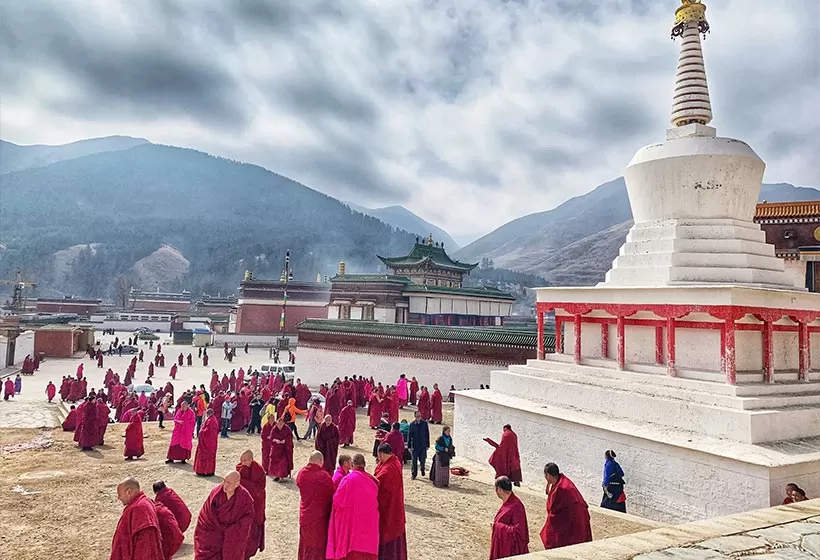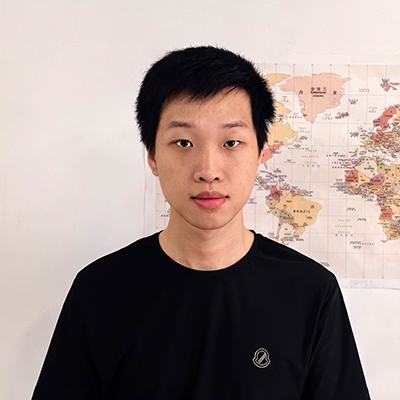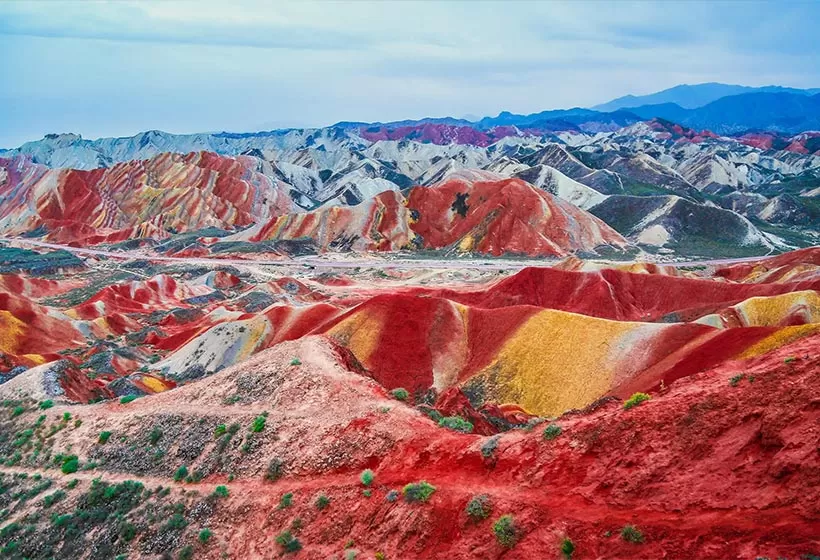Short Introduction to Gansu Local Culture: History, Nation, Diet, Heritage, etc.
Gansu Province, located in the upper reaches of the Yellow River in China, is vast in area, rich in history, and deep in cultural heritage. It is hailed as the "birthplace of Chinese civilization, a museum of natural wonders, a grand showcase of ethnic customs, and a destination for quality tourism". Gansu is a meeting point of agricultural and nomadic civilizations as well as Central Plains and Western cultures, with unique Long cuisine, rich local customs, and historic cultural cities contributing to the comprehensive cultural identity of Gansu.
Brief History
Gansu, historically known as the region of "Yong and Liang", takes its name from the ancient Ganzhou State (now Zhangye) and Suzhou State (now Jiuquan), abbreviated as "Gan". It is als referred as "Long" due to its location west of Long Mountain (Liupan Mountain).
Gansu is one of the cradles of the Chinese nation and civilization. Evidence of human activity in the region dates back over 200,000 years to the early Paleolithic era in eastern Gansu. The Zhou and Qin tribes rose to power in eastern Gansu, eventually establishing the Zhou and Qin dynasties.
During the Qin and Han periods in 121 BCE, General Huo Qubing led two military campaigns against the Xiongnu, followed by large-scale Han migrations leading to the first agricultural boom in Gansu. Zhang Qian's expeditions to the Western Regions established the Silk Road, linking China to the West.
During Sui and Tang Dynasty in 609 BEC, Emperor Yang of the Sui held a "World Exposition", meeting envoys from 27 Western countries, which furthered economic and cultural exchange between China and the West.
During the Song dynasty, multiple regimes controlled different parts of Gansu. Eventually, the Xia regime unified the Hexi region and established the Western Xia dynasty that the name of “Gansu” first appears.
In the early and mid-Qing dynasty, Gansu experienced significant growth due to favorable economic policies and large-scale agricultural development, leading to a population boom and peak agricultural production. During the anti-Japanese war period, Gansu developed modern industries, transportation, science, and education, playing a key role in the war effort.
After Gansu's liberation in August 1949, the Gansu Administrative Office was established, followed by the formation of the Gansu Provincial People's Government in 1950.
Region Culture
Gansu culture is a vital part of the rich tapestry of China's multi-ethnic and unified cultural heritage, which has a long historical tradition and distinctive regional characteristics. With geography stretching across a vast distance from east to west, Gansu culture are rich and diverse in their composition series.
Dunhuang culture is a blend of architectural art, sculpture art, mural painting, and Buddhist culture, deeply rooted in history and offering immense cultural depth. Dunhuang culture is the result of the integration and blending of multi-ethnic culture, Chinese and Western cultures, and is the world culture absorbing various cultures in the world. It is also the world's largest extant, longest lasting, and most complete art treasure house.
The culture of the Silk Road is the culture spread and derived from the Silk Road. The ancient Silk Road runs for over 1,600 kilometers through Gansu and national historic and cultural cities such as Dunhuang, Wuwei, Zhangye, and Tianshui. The Great Wall remnants along the Hexi Corridor, the cave complexes like the Mogao Caves, and the discovery of over 61,000 bamboo slips all underscore the profound and gorgeous along this golden stretch of the Silk Road.
Fuxi culture is considered the foundation of Chinese civilization. Fuxi, both a historical figure and tribal leader, symbolizes an era and cultural identity, revered as the ancestral progenitor of the Chinese people. The dragon culture created by Fuxi has become a spiritual link binding the Chinese nation, symbolizing the concentrated embodiment of national tradition, national feeling and national spirit.
Ethnic Culture
Gansu has long been a place where multiple ethnic groups coexist, from its primeval forests to the Gannan grasslands, from the Qilian Mountains to the oasis of the Gobi Desert, and from the banks of the Yellow River to the Loess Plateau. This diverse region is home to Han, Hui, Tibetan, Mongolian, Kazakh, and other ethnic groups. Among them, Gansu has three ethnic groups unique to the province: the Yugur, Dongxiang, and Bao'an people.
The Gannan Tibetan Autonomous Prefecture has been a traditional Tibetan settlement since ancient times. The Tibetan people, who live mainly on the Qinghai-Tibet Plateau and its surrounding areas, primarily rely on nomadic herding, moving with the seasons. They wear traditional Tibetan robes, live in tents, and eat yak meat and tsampa. Tibetan life is deeply centered on their Buddhist faith, and the people are known for their generosity and hospitality, with unique song and dance art.
The Yugur people are concentrated in the Subei Yugur Autonomous County with a rich and sometimes tragic history. Their tough journey through history, marked by several migrations, has shaped their resilient, brave character and broad-minded mind. Known for their simplicity and hospitality, the Yugur people have preserved many unique customs in their clothing, food, marriage, and funeral traditions, particularly famous for their musical and dancing skills.
The Bao'an people, settled in Linxia region, are a Muslim group with notable cultural traditions. Their weddings, characterized by their energetic celebrations, are worth mentioning. From the initial wedding preparations to the bride's reception, everything is filled with noise and excitement, day and night. Known as "the champion of liveliest wedding", reflecting the Bao'an people's straightforward, joyful nature.
The Dongxiang people is named after living in the Dongxiang County in the Linxia, that Islam has played a decisive role in shaping their ethnic identity. The Dongxiang people have lived in isolated and backward mountainous areas, often facing harsh conditions, which have cultivated their hardworking, honest, and intelligent nature. Though their material wealth may be limited, Dongxiang people are especially known for their hospitality.
Special Festivals
The Hui people’s Eid al-Fitr, held on the 1st day of the 10th month in the Islamic calendar, is their most important festival, celebrating the completion of a month of fasting (Ramadan). During Ramadan, Hui Muslims abstain from food and drink from dawn until sunset. On the day of the festival, people bathe dress in their finest clothes, and head to the mosque for prayers.
In Gannan, Tibetan Buddhist monasteries hold the Great Prayer Festival from the 3rd to the 17th day of the lunar new year. This is the most festive time in the region, with various ceremonies and celebrations. It is the best time for those interested in Tibetan folk art and religious culture to visit Gannan.
The Sunning Buddha Festival is held on the 13th day of the first lunar month. Led by the monastery's senior lamas, monks carry a giant Thangka depicting a Buddha image to the monastery’s nearby sunning Buddha platform. Thousands of monks and devotees gather to chant prayers, that the scene was very spectacular..
The Xianglang Festival is a romantic and interesting celebration held by Tibetan communities from early to late June in the lunar calendar. During this period, the locals engage in traditional games and activities, such as horse racing, yak racing, tug-of-war, wrestling, running races, singing, and dancing.
The China Silk Road Festival, held in mid-September every year, offers travelers a special tour of Dunhuang. Starting in Lanzhou and traveling west along the foothills of the Qilian Mountains, the route passes through Wuwei, Zhangye, Jiuquan, and Jiayuguan, ending in Dunhuang, with various local specialty products along the way.
Diet Style
Gansu cuisine, also known as Long cuisine, is deeply rooted in the Silk Road's rich cultural heritage, drawing from local ingredients and influenced by the Dunhuang culture and Halal custom. It blends traditional flavors with cooking techniques from various Chinese culinary schools, creating a distinctive gastronomic system.
Gansu's diet predominantly consists of wheat-based foods, with a wide variety of noodle dishes, among which noodles in soup take over the most varieties, with great local characteristics. There are also steamed buns, pancakes as the representative of solid food. Supplemented coarse cereals such as corn, potatoes, buckwheat, and beans are also widely used in cooking. Gansu people enjoy bold, tangy flavors, with pickled vegetables, chili oil, and vinegar being essential condiments for noodle with soups. Fermented beverages like Jiangshui (a sour liquid made with vegetable soup mixed with starch) are also popular.
During the summer, the people of Gansu have a preference for cold dishes, often available at food stalls. Popular options include rang pi zi, cold noodles, laozao (sweet fermented rice), and hui douzi, that, aside from sweet ones, are often seasoned with savory ingredients like salt, vinegar, chili oil, sesame paste, and garlic water so as to a refreshing, spicy-sour flavor. In southern Gansu, some regions prefer raw or cold dishes and rarely eat hot food. In terms of meat, Gansu people enjoy beef and lamb, along with dairy products, as the region's animal husbandry significantly influences their diet.
Cultural Heritage
Gansu, stretching from east to west, is home to seven UNESCO World Heritage sites that are scattered like stars across the region. These include the solemn Buddha statues of the Maiji Mountain Grottoes, the vibrant murals of the Bingling Temple Grottoes, the mighty walls of Jiayu Pass, the ancient remnants of the Suoyang City Ruins, the mysterious bamboo slips of the Xuanquan Posthouse, the treasures statues of the Dunhuang Mogao Caves, and the imposing Yumen Pass. The Silk Road runs through this region, connecting a rich array of historical and cultural sites, much like a grand symphony linking each moving note of history.
Gansu’s intangible cultural heritage is also unique and colorful. The delicate Qingyang sachets, the distinct Zhuanglang Gaotai, and the exquisite Tao River Green Stone Ink Slabs consist of the cultural treasures. Along with Gansu boasts traditional arts such as Huanxian shadow puppetry, Gannan Tibetan opera, Gannan Tibetan thangka, and Longxi Yunyang clapper talk, all of which reflect the hard work, creativity, and wisdom of the people of Gansu.
Customize Your Unique Gansu Silk Road Trip

If you are interested in one of the Gansu itineraries mentioned above, please contact us, and we will be happy to customize it and provide a quote tailored to your preferences.
Alternatively, if you would like to customize your Gansu Tour, please visit our Gansu Tour Customized Center. We assure you that you will receive a reply within 24 working hours.
Informative Articles for Your Gansu Trip
 the Silk Road
the Silk Road- Travel Guide: attractions, weather, hotels, food, etc.
- Top destinations: best places to visit in Gansu
- Travel itineraries: itineraries for your reference
- Local culture: brief history, folk culture, festivals, etc.
- Weather: the best time and seasons to visit Gansu
- Top attractions: sightseeings to watch in Gansu
- Cultural immersions: activities to spotlight your trip
- Unique perspective: best interesting things to do
- Local food: what to eat while traveling in Gansu
- Luxury hotels: best accommodation to stay in Gansu
- Dunhuang Tours: customized Gansu tours for your reference
GREAT FAMILY CHINA TOUR
JULY 2024 We wanted to thank Grace at China Culture tour for organizing a great tour of China. We enjoyed our Beijing - Xian-Chengdu -Guilin -Yangshuo - Shanghai trip. Our local guides Bruce in Beijing, Susan in Xian, Jane in Chengdu, Mike in Guilin and Mary in Shanghai took care of us…read more details »
Teng Han L from SINGAPORE
Ready to Create a Unique Dream Travel?


